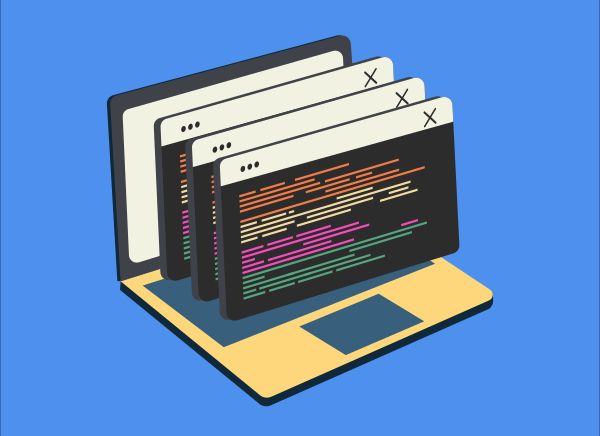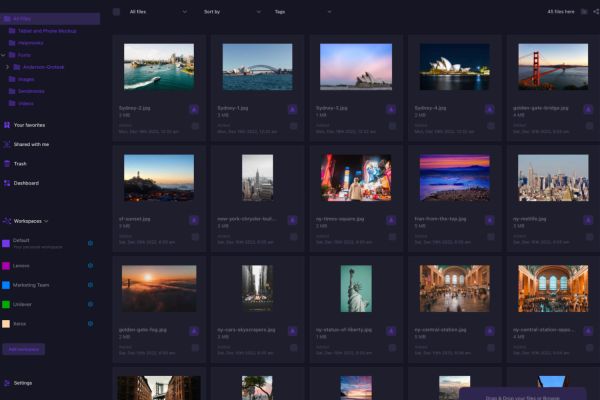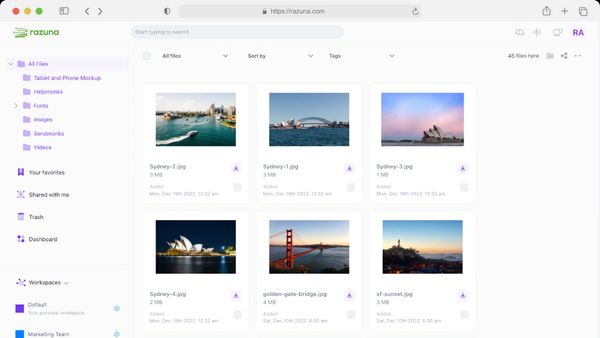
What Is Digital Asset Storage?
What is digital asset storage? This guide to digital asset storage has all the answers. Learn how to implement digital asset storage for all your teams.
Read nowYou're working on a creative project with tight deadlines, numerous tasks, and a team of diverse professionals. Needless to say, there’s a lot to keep track of. Without proper creative workflow management to control the feedback process and keep deadlines on track, it’s easy for progress to veer off course, deadlines to fall by, and tasks to become unmanageable.
No doubt, this scenario is painfully familiar to many. Here we’ll discuss how to best manage the creative workflow to avoid being bogged down by inefficient processes.
A creative workflow refers to the unique process creative professionals follow, from conceptualizing ideas to executing and completing their projects. This includes the interaction between team members, necessary modifications, revisions, approvals, and final delivery of polished work.
This workflow is not confined to the individual artistic process but is embedded within the broader team dynamics and client relations. It is an intricate system with many moving parts, including tools and techniques to ensure the smooth delivery of your creative projects.
Creative workflow management involves organizing, tracking, and streamlining the entire creative process from project initiation to completion. It does so, ensuring that optimized output quality is achieved.
Part of the process is guaranteeing that resources are utilized in the best possible way, tasks are prioritized, and deadlines are met with satisfactory results.
Managing creative workflow effectively comes with a myriad of benefits, including:
One of the biggest benefits of creative workflow management is that it facilitates the timely delivery of high-quality projects. By streamlining the process, teams can work efficiently and collaboratively to produce better results.
When projects are managed effectively, team members can focus on producing the best possible work without being bogged down by superfluous tasks and mundane paperwork. This not only boosts productivity but also leads to higher customer satisfaction.
The creative process requires close collaboration between team members at all stages of the project. Creative workflow management makes it easier for creatives to work together and coordinate their efforts.
This is because all tasks, deadlines, and other activities are easily accessible and transparent. All parties are informed of the progress made, the aligned objectives, and the necessary next steps. The communication is clear and transparent.
This improves productivity as well as the flow of information between relevant stakeholders.
Whether your current project involves creating a simple logo and slogan for a company, or developing an entire branding strategy, the creative process can be costly. Luckily, creative workflow management has the potential to reduce overhead costs significantly. When you manage and track tasks effectively, your team can identify areas of improvement and make changes accordingly.
This leads to greater efficiency in resource allocation and cost savings for the company.
Creative workflow management helps ensure the creative process runs smoothly and efficiently by reducing potential bottlenecks. Various factors account for such limitations, including poor communication, inadequate resources, or team coordination. Setting up a tracking system for each project allows you to identify potential problems long before they turn into serious issues.
This provides an opportunity to address and resolve them as soon as they arise. In turn, this helps to reduce delays and increase productivity.
Effective creative workflow management helps to streamline the creative process. Establishing a structured system that outlines project requirements clarifies team roles and assists everyone in proceeding with their work.
For instance, say you have five phases of project development. A workflow management system will furnish a lucid outline of tasks each creative should accomplish according to a schedule. The outcome ensures that the team stays on track and delivers timely results without missing tasks or deadlines.
This helps to keep everyone on the same page and minimizes the risk of delays or errors due to confusion or miscommunication.
Combined with effective brand management, creative workflow management may help optimize resources. With a clear outline of each stage of the process, teams can better plan for the resources they need. This reduces waste and helps ensure the project is completed on time and within budget.

Outline the desired outcomes, target audience, key performance indicators (KPIs), and deadlines for your project. This establishes a roadmap and serves as a reference throughout the workflow.
Align the goals and objectives with your overall business strategy and be SMART (Specific, Measurable, Achievable, Relevant, and Time-based) about it. While you’re at it, communicate these with the entire team.
Once you’ve set the project’s goals, assemble a team of individuals with the necessary skill sets.
Ensure your team comprises individuals with diverse skills and experiences—strong designers, copywriters, editors, and project managers. Assign each team member with specific tasks to ensure maximum efficiency.
When setting up a team, there are a few tips you should keep in mind:
Develop an organizational framework to ensure smooth workflow. This should include roles and responsibilities, as well as specific timelines and deadlines for tasks.
The structure should also outline how tasks are assigned and completed. This will keep team members on track and help them stay organized when working on the project.
Once you’ve assembled your team, it’s time to create an effective workflow.
To do this, you must first define processes, protocols, and standards for your team to follow. This helps ensure that everyone knows what is expected of them so that they can easily accomplish their tasks. It also allows for clarity and communication between members of the team.
When laying out these processes and protocols, thinking about the project's goals is crucial. Doing so will help you create a workflow that focuses on results rather than mundane tasks.
Additionally, each protocol should be specific enough so that everyone can easily follow them. At the same time, they shouldn’t be too restrictive to limit creativity or collaboration.
Once these processes and protocols are in place, your next step is establishing quality assurance standards. This includes setting guidelines for deadlines, accuracy, and other measures of success. Doing so ensures that everyone on the team is held to a standard of excellence and will help you achieve the desired outcome of your creative project.
By having well-defined processes, protocols, and standards, you can effectively manage your creative workflow and ensure the project is completed on time and to a high standard.
A task hierarchy is an essential part of any successful workflow. It helps ensure that tasks are completed in a logical order and prevents overlapping work. Establishing a task hierarchy should be done in tandem with laying out processes and protocols – once you know what needs to be done, you can then prioritize the tasks.
When creating the task hierarchy, it’s essential to consider the complexity of each task and its importance. This helps you ensure that high-priority jobs are handled first while leaving time for more complicated tasks.
Additionally, a logical task hierarchy can help reduce stress levels and improve overall efficiency.
By establishing a good task hierarchy, your team can quickly and easily identify what needs to be done and who is responsible for it. This will help ensure that tasks are completed on time and in an organized manner.
Schedule regular check-ins or meetings to update the team on progress, identify bottlenecks, and ensure deadlines are met. This helps the team stay on track and be aware of any possible issues or delays.
Schedule these check-ins frequently and allow everyone to openly discuss their progress, ask questions, and offer solutions. Additionally, it’s important to set milestones for these checkpoints so that teams can stay organized and motivated throughout the project.
51% of businesses invest in automation to improve efficiency. Therefore, yours should not be left behind. Use automation tools to minimize repetitive manual work and save time for more creative endeavors. The key is to find the right balance between manual and automated tasks, so you don’t miss any critical details.
Automation tools can also provide additional quality assurance as they are less likely to make mistakes or overlook details. Additionally, they help reduce the burden on your team and free up resources for more creative endeavors.
Monitor workflow efficiency, resource allocation, and progress through analytics and reporting tools. Adjust plans accordingly to optimize productivity. This helps ensure you don’t overlook important tasks and meet your deadlines.
By tracking project progress, you can quickly identify any issues or areas of improvement. Additionally, it allows the team to stay organized and motivated by clearly seeing how their work contributes to the project goals.
Conduct post-project analysis to evaluate what worked, what didn't, and how you can improve future workflows.
Make sure to capture lessons learned and apply them to future projects. This helps ensure the team continues to learn and develop, improving workflow efficiency over time.
Following these steps can profoundly influence the overall success of your creative projects. Optimized creative workflows can increase productivity and reduce burnout, leading to a healthier and more satisfied team.
By implementing these practices and embracing the power of continuous improvement, you can master the art of productivity and watch your creative projects flourish.
Want a way to manage your creative digital assets more effectively? Take a look at Razuna’s digital asset management platform. It’s a winner for organizing, sharing, and collaborating on your brand assets with your team.

What is digital asset storage? This guide to digital asset storage has all the answers. Learn how to implement digital asset storage for all your teams.
Read now
All files that your business uses is a type of digital asset. This guide explains the various types, what makes them crucial, and how best to manage them.
Read now
A digital asset management strategy is essential for your brand. This guide explores how to maximize your brand's potential with this powerful combination.
Read now
File organization is essential for any business. Here are 10 of the best file organization software options for businesses of all types to consider in 2024.
Read now
(each free accounts comes with 500 GB space)
